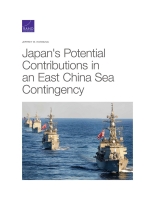by Jeffrey W. Hornung
What roles could Japan play should a high-end contingency erupt in the East China Sea that finds the United States engaged in major combat operations with China?
What are the strengths and weaknesses of the SDF?
What legal and political factors are likely to influence Japan's decisions to support the United States, allow the United States to access its bases in Japan for combat, and authorize the SDF to use force?
How can Japan better position itself to respond to a regional contingency, and how can the United States support Japan in these efforts?
In the Indo-Pacific region, the alliance the United States has with Japan is arguably its most important. If a high-end contingency erupts in the East China Sea and the United States becomes engaged in major conventional combat operations with China, what roles can and might Japan play? In this report, Jeffrey W. Hornung assesses the strengths and limitations of Japan's Self-Defense Forces (SDF), as well as legal issues pertaining to the SDF use of force and U.S. base access in a contingency for combat operations that may not be directly tied to the defense of Japan.
Hornung finds that, despite Japan's focus on self-defense, there are significant areas in which the SDF can assist the United States. He identifies strengths and weaknesses of the capabilities of each of the three SDF services — both current and expected over the next decade — and steps that could be taken to enhance these capabilities. Hornung also examines bilateral agreements and Japanese laws that govern how SDF capabilities may be employed and whether U.S. forces can expect to access their bases in Japan for combat operations. Hornung makes specific recommendations on how to ensure more effective and capable Japanese support in an East China Sea contingency involving China, including how Japan could better position itself to respond, both for its own defense and in support of the United States, and how the United States could better support Japan in these efforts.
Key Findings
The SDF has many strengths but also faces important challenges
The Ground Self-Defense Force's shifts toward greater mobility and dispersed posture have improved its ability to respond to an attack in the East China Sea, but it has relatively little intelligence-gathering assets and shaping capability, and there are questions as to how quickly it can respond over distance.
The Air Self-Defense Force has advanced fighters, but not of all its platforms are equally modernized, and it lacks anti-jamming capabilities and adequate logistical support capabilities, including a robust fleet of aerial refuelers.
The Maritime Self-Defense Force's greatest strength is its ability to defend sea lines of communication, conduct chokepoint control, and perform anti-submarine warfare, but it also faces logistical challenges.
Overall, the SDF's strengths are its high levels of interoperability with U.S. forces, its air and missile defense systems, and movement into the new domains of space, cyber, and the electromagnetic spectrum. Key challenges are that the SDF lacks many important capabilities, its three component services do not have a high degree of jointness, and it faces falling recruitment levels and an aging force.
Japan's self-defense orientation has important implications for U.S.-Japan cooperation in a contingency
Despite Article 9 of Japan's constitution renouncing war and the threat or use of force as a means of settling international disputes, there are areas Japan can support the United States in a contingency — including the use of force — depending on certain conditions being met.
The United States is legally required to consult with Japan prior to employing U.S. forces from its bases in Japan for combat operations that are not directly tied to the defense of Japan.

No comments:
Post a Comment